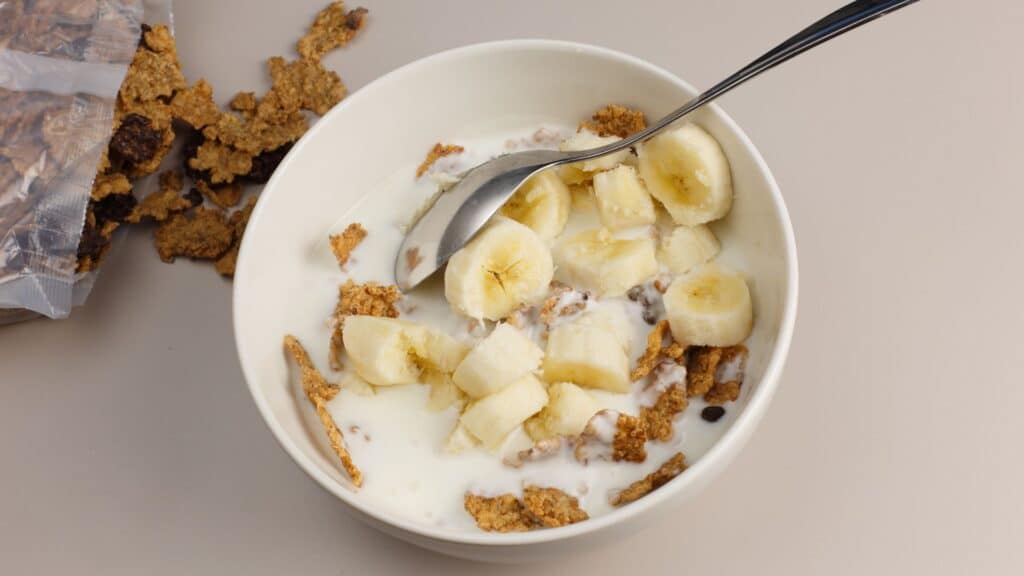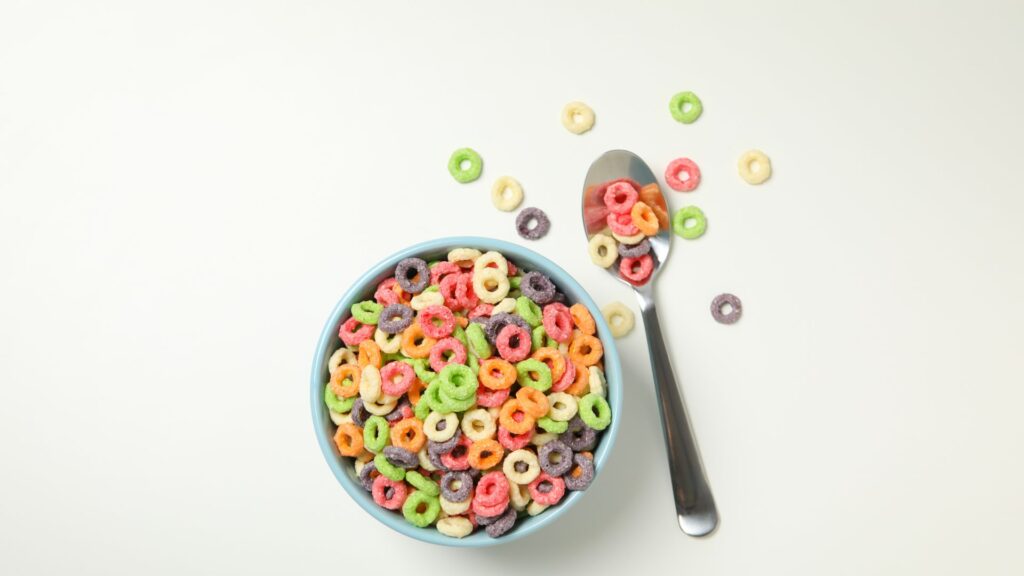Incorporating cereal into an infant’s formula is a topic of interest for many parents, particularly those grappling with their baby’s sleep patterns or seeking to enhance their nutritional intake. However, before implementing this practice, weighing the potential pros and cons is crucial.
This article explores the benefits and drawbacks of integrating cereal into a baby’s formula, highlighting aspects such as increased satiety, improved sleep patterns, and enhanced nutrient consumption.
Conversely, the possible risks and disadvantages encompass heightened choking hazards, digestive complications, diminished milk consumption, the postponed introduction of solid foods, and a lack of verified benefits.
Furthermore, the article offers guidance on safely introducing cereal into a baby’s formula, stressing the significance of consulting a pediatrician and progressively incorporating cereal with the appropriate variety, texture, and nipple flow.

The Benefits of Mixing Baby Formula with Cereal
Infant cereal, a vital component in a baby’s diet, plays a significant role in the development of a healthy baby’s digestive system. As a parent, we are perpetually committed to ensuring optimal nutrition for our little ones. A growing trend in infant feeding involves combining baby formula with cereal, which helps in providing essential nutrients and fostering the overall well-being of our healthy babies’ bright futures.
Here are the potential benefits of this practice, including:
1. Enhanced Satiety
A key motivation for parents to mix baby formula with cereal is to promote a lasting sense of fullness in their infants. Given the small size of babies’ stomachs, they often experience hunger quite frequently. By adding infant cereal to their formula, parents hope to create a more substantial meal that will keep their little ones satisfied and reduce the frequency of feedings.
2. Better Sleep Patterns
Numerous parents grapple with helping their babies sleep soundly throughout the night. A widespread notion suggests that incorporating cereal into baby formula can enhance sleep patterns by keeping infants satiated for extended periods. The underlying concept is that contented babies are less prone to awakening from hunger, leading to a more restful night for both the child and parents.
3. Augmented Nutrient Consumption
In certain instances, blending cereal with baby formula can boost a meal’s overall nutrient composition. Cereal is frequently enriched with vital vitamins and minerals, such as iron, zinc, and B. Infants may reap the rewards of a more varied and nourishing meal with nutrient-rich baby formula.
Despite these possible advantages, seeking a pediatrician’s advice before introducing cereal into your baby’s nutritional regimen is crucial, particularly for those under four months old. Concerns exist that incorporating cereal into baby formula may result in overfeeding and elevate the risk of obesity later in life.
Moreover, some infants may not be developmentally prepared for solid foods, and an early introduction of cereal could trigger digestive complications.

The Risks and Drawbacks of Adding Cereal to Baby Formula
There are potential risks and drawbacks associated with this practice, which include an increased risk of choking, digestive issues, and reduced milk intake.
Let’s delve deeper into these concerns and provide a better understanding of the potential consequences.
1. Increased Risk of Choking
A foremost worry regarding the incorporation of cereal into a baby formula is its potential choking danger. The formula’s increased viscosity, resulting from the cereal addition, could complicate the swallowing process for infants, creating a choking hazard. This risk is particularly heightened in younger babies without appropriate swallowing abilities or coordination. To mitigate this threat, parents are advised to consult a pediatrician before altering their child’s feeding practices and adhere to healthcare professionals’ guidance.
2. Digestive Complications
Introducing cereal to baby formula might also contribute to digestive problems in certain infants. Babies have delicate digestive systems that may not be ready to handle the added complexities of cereal in their diet. Mixing cereal with formula may cause stomach discomfort, gas, bloating, and constipation, particularly in infants younger than six months old. Introducing solid foods too early can also increase the risk of developing food allergies or sensitivities.
3. Reduced Milk Intake
For optimal growth and development, infants require sufficient breast milk or formula consumption. Combining cereal with formula may decrease milk intake, as babies could feel satiated from the cereal and subsequently ingest less formula. This decline in milk consumption may contribute to nutritional deficiencies, as infants might not obtain the crucial vitamins, minerals, and nutrients solely from formula or breast milk.
4. Postponed Initiation of Solid Foods
Though adding cereal to baby formula seems like an easy way to introduce solid foods, it can delay the appropriate introduction of a variety of solid foods. Babies should gradually be introduced to different tastes and textures through an age-appropriate solid foods diet. Relying on cereal mixed with formula may limit their exposure to diverse foods, potentially impacting their growth and development.
5. No Proven Benefits
No evidence supports the notion that adding cereal to baby formula improves sleep or offers extra nutrients. Research indicates that babies consuming formula with added cereal show no significant difference in sleep patterns compared to those without. Parents who feel their baby needs more nourishment should consult a pediatrician for advice on appropriate feeding practices.

Introducing Baby Rice Cereal and Other First Foods: A Guide for Parents
As your little one reaches the milestone of starting solid foods, you may wonder how to begin the journey. One of the first steps is selecting the appropriate cereal for your baby.
Selecting the Right Cereal for Your Baby:
Regarding infant rice cereals and other grain cereals, choosing an iron-fortified, single-grain option such as rice or oatmeal is essential. These cereals are easily digestible and less allergenic, perfect for your baby’s sensitive digestive system. Refrain from using adult cereals containing added sugars and other unsuitable infant ingredients, as these can hinder your child’s development and overall health.
Introducing Rice Cereal to Your Baby’s Diet:
When your baby is six months old, you can add rice cereal into their feeding routine. Begin with a thin consistency by mixing a small amount of rice cereal with breast milk or formula. Gradually increase the thickness as your baby becomes more comfortable eating solid foods. Adding rice cereal slowly gives your baby time to adjust to different tastes and textures.
Expanding Your Baby’s Diet with Pureed Vegetables:
After your baby successfully transitions to rice cereal, you can add pureed vegetables to their diet. Begin with single-ingredient vegetable purees, such as sweet potatoes, carrots, or peas, before moving on to various vegetables. This gradual introduction will help your baby develop a taste for different flavors and provide essential nutrients for their growth.
Transitioning from Infant Rice Cereals to Other Grain Cereals:
Once your baby has become accustomed to rice cereal and pureed vegetables, you can introduce other grain cereals, such as oatmeal or barley. Like putting rice cereal on the menu, introducing these new grains should be a gradual, thoughtful process to ensure your baby continues to receive the necessary nutrients for their development while expanding their palate.
When it comes to solid food, baby food options are vast, ranging from store-bought purees to homemade concoctions. Feeding rice cereal is often the first step, as it’s easy to digest and has a mild flavor. As your baby becomes more comfortable with solids, you can expand their palate by introducing various fruits, vegetables, and protein sources.
Always consult with your pediatrician for specific guidelines and recommendations tailored to your child’s needs.

Safely Incorporating Cereal into Baby Formula
Although most healthcare professionals advise waiting until babies are between four and six months old to introduce solid foods, some parents prefer adding cereal to their baby’s formula to address hunger or reflux issues.
If you opt to include cereal in your baby’s formula, it is crucial to do so safely and effectively. The following tips will help you navigate this process:
Consult Your Pediatrician:
Before altering your baby’s diet, discuss your intentions with their pediatrician. They can guide the suitability of adding cereal to your baby’s formula and recommend the appropriate type and consistency.
Select the Appropriate Cereal:
Choose an iron-fortified, single-grain baby cereal, such as rice or oatmeal, as these options are easily digestible and less allergenic. Please refrain from using adult cereals containing added sugars and other unsuitable infant ingredients.
Begin with a Thin Consistency:
When introducing cereal to your baby’s formula, start with a thin consistency. Combine one teaspoon of cereal with the formula, aiming for a slightly thicker texture than the regular formula. As your baby gets used to the cereal, you can incrementally increase the amount to achieve a denser consistency.
Utilize a Slow-Flow Nipple:
To prevent choking, use a slow-flow nipple on your baby’s bottle when feeding them the cereal-enhanced formula. This precaution ensures your baby can safely swallow the thicker consistency without feeling overwhelmed.
Introduce Cereal Gradually:
Begin by offering the cereal-infused formula to your baby once a day, and slowly increase the frequency as they adapt to the new texture. Always monitor your baby’s reaction and tolerance to the cereal, and consult your pediatrician if you have any concerns.
Watch for Signs of Readiness:
Look for signs that your baby is ready for cereal, such as holding their head up, showing interest in food, and having doubled their birth weight. If your baby struggles with the thicker consistency or shows signs of discomfort, it may be best to wait a few weeks before trying again.
Don’t Overdo It:
Remember that adding cereal to your baby’s formula supplements their diet, not replacing their regular formula intake. Continue offering regular formula feedings to ensure your baby receives all the necessary nutrients for proper growth and development.

Alternatives to Adding Cereal to Baby Formula
As parents navigate the early stages of their baby’s growth and development, they often encounter the debate on whether or not to add cereal to baby formula. While some believe it can help babies sleep longer and provide additional nutrients, others are concerned about the potential risks, such as choking hazards or overfeeding.
For those seeking alternative approaches to improve their baby’s nutrition and sleep patterns, consider the following options:
Introducing Solid Foods Gradually:
The American Academy of Pediatrics recommends starting solid foods around six months. Begin with single-grain, iron-fortified cereals, such as rice or oatmeal, followed by pureed fruits, vegetables, and lean proteins. This gradual introduction allows babies to adapt to new textures and flavors while reducing the risk of allergies and digestive issues.
Adjusting Feeding Schedules:
If your baby struggles with sleep, try adjusting their feeding schedule to help establish a routine. Offer more frequent, smaller meals during the day and a more substantial feeding before bedtime to help them feel satisfied and sleep better.
Dream Feeding:
Dream feeding involves giving your baby a quiet, dimly lit feeding right before you go to bed without fully waking them. This can help keep your baby satisfied throughout the night and promote longer sleep stretches.
Encouraging Self-Soothing:
Teach your baby self-soothing techniques, such as sucking on their hand, using a pacifier, or cuddling a soft blanket. These methods can help babies fall asleep and return to sleep more quickly when they wake at night.
Opt for a More Substantial Formula:
If your baby seems unsatisfied with their current formula, consider switching to a more substantial option. Some formulas contain more calories from fat or carbohydrates, which may help your baby feel fuller and sleep better. Consult your pediatrician before making any changes.
Create a Consistent Sleep Environment:
Establishing a predictable bedtime routine and creating a calm, dark, and quiet sleep environment can help signal your baby that it’s time for sleep. This consistency can be beneficial in promoting longer sleep stretches.
Seek Professional Guidance:
If you are concerned about your baby’s sleep patterns, consult your pediatrician or specialist. They can help identify underlying issues and tailor recommendations to improve your baby’s sleep.

Conclusion
In conclusion, mixing cereal with baby formula can have potential benefits, such as improving satiety, better sleep patterns, and increased nutrient intake.
However, this practice has risks and drawbacks, such as an increased risk of choking, digestive issues, reduced milk intake, and delayed introduction to solid foods.
It’s important to consult with a pediatrician before introducing cereal into your baby’s diet, especially if they are under four months old.
If you decide to add cereal to your baby’s formula, follow the earlier tips to ensure that you do so safely and effectively.
Remember that every baby is different and may have unique needs and requirements, so it’s important to consult your healthcare provider to determine what’s best for your baby.
As parents, we want to provide our babies with the best nutrition possible. By understanding the potential benefits and drawbacks of adding cereal to baby formula, we can make informed decisions about our baby’s feeding routine and ensure they receive the best possible care.
Did you find this article helpful? We’d love to hear from you! Have a question? Let us know in the comments.



